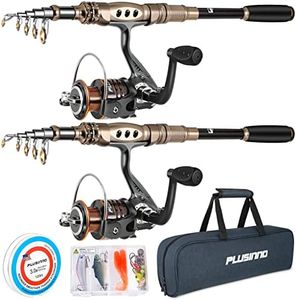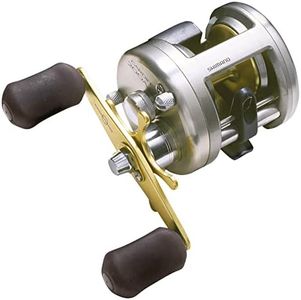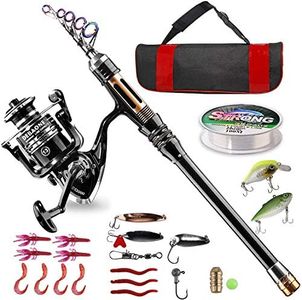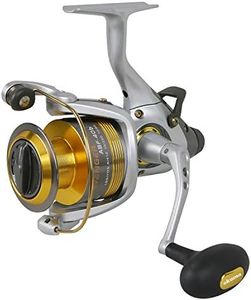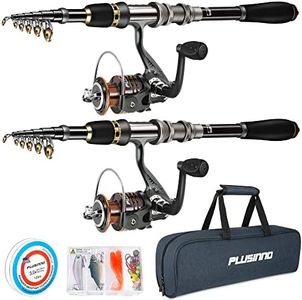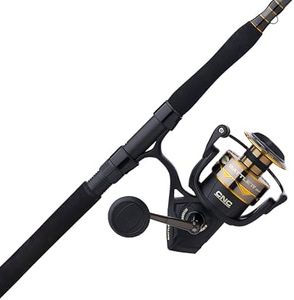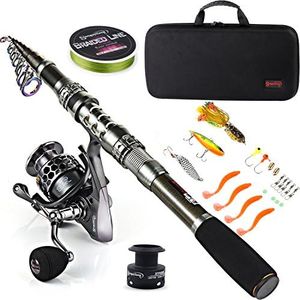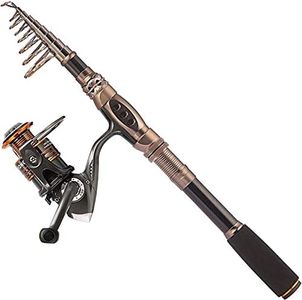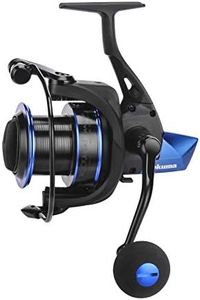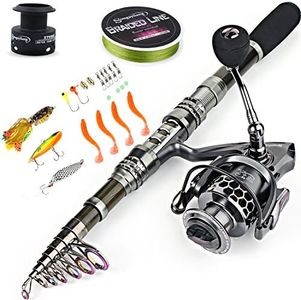We Use CookiesWe use cookies to enhance the security, performance,
functionality and for analytical and promotional activities. By continuing to browse this site you
are agreeing to our privacy policy
10 Best Deep Sea Fishing Rods And Reels
From leading brands and best sellers available on the web.Buying Guide for the Best Deep Sea Fishing Rods And Reels
Choosing the right deep-sea fishing rod and reel is important to make sure your fishing experience is enjoyable and successful. Deep-sea fishing requires equipment designed to handle large, powerful fish and challenging conditions at sea. When selecting your gear, think about the type of fish you want to catch, how often you plan to go fishing, and your own physical comfort with the rod and reel. Understanding different features and specifications will help you match your gear to your needs, making your time on the water more productive and fun.Rod LengthRod length is the measurement from the handle to the tip of the rod and plays a key role in casting distance, leverage, and control over your catch. Shorter rods, usually between 5 to 6 feet, are great for fighting large fish since they give you more lifting power and control in close quarters. Medium-length rods around 7 feet offer a good balance for versatile fishing styles, while longer rods (over 7 feet) help you cast farther but may be harder to manage with heavy fish. Choose your rod length based on whether you want more power to bring fish in or more range to cast your line farther.
Rod Power and ActionRod power refers to how much force it takes to bend the rod, which is marked as light, medium, heavy, or extra heavy, while action describes where the rod bends along its length—fast, medium, or slow. Heavy power rods are made to handle big, strong fish often found offshore, and they work best with heavier lines and lures. Fast action rods bend near the tip, offering quick response and good hook-setting ability, which is useful when fighting aggressive species. Picking the right power and action depends on the type of fish you'll pursue and your fishing technique; for most deep-sea trips, a rod with heavy power and fast or medium-fast action is a safe bet.
Reel TypeThere are two main types of reels for deep-sea fishing: spinning reels and conventional (or baitcasting) reels. Spinning reels are easier to use and good for beginners, working well with lighter lines and smaller fish, but can struggle with the biggest catches. Conventional reels are built with more strength and line capacity for big game fish and tough battles, but require more skill to operate. Think about your experience level and the size of fish you're targeting when choosing the type of reel that suits you best.
Line CapacityLine capacity tells you how much fishing line the reel can hold, usually marked as yards of a given pound-test line. Deep-sea fish can make long, fast runs, sometimes requiring hundreds of yards of line, so a higher capacity is often necessary. Light fishing may only need 200-300 yards, while targeting big game fish could require 400 yards or more of heavy line. Your target fish and fishing style should lead your decision here: go with higher capacity if you plan to chase larger species or fish in deeper waters.
Drag SystemThe drag system controls how much resistance a fish feels when pulling on your line, helping you tire out strong fish without the line breaking. A smooth and powerful drag is vital for deep-sea fishing because big fish make unpredictable runs. Drag strength is usually rated in pounds; the higher the rating, the more stopping power you have. Aim for a drag system that can handle at least a third to half of the breaking strength of your fishing line, and always look for smooth, reliable drag adjustment.
Rod and Reel MaterialMaterials used in rods (like fiberglass, graphite, or composites) and reels (such as aluminum or graphite) affect strength, weight, and durability. Fiberglass rods are tough and bend-resistant but a bit heavier; graphite rods are lighter and more sensitive but can be less durable under extreme strain. Aluminum reels are strong and corrosion-resistant, which is great for saltwater, while graphite reels are lighter but not as tough. Pick a combo that offers both strength and comfort, taking into account how long you’ll be holding the rod and the saltwater environment.
Corrosion ResistanceSaltwater can quickly wear out fishing equipment, so corrosion resistance is a crucial feature. This is usually achieved through special coatings on reels and rods, as well as the use of stainless steel or similar metals in key parts. If you plan to fish often in saltwater, make sure your gear is specifically designed to resist corrosion, which will help it last longer and maintain performance.

